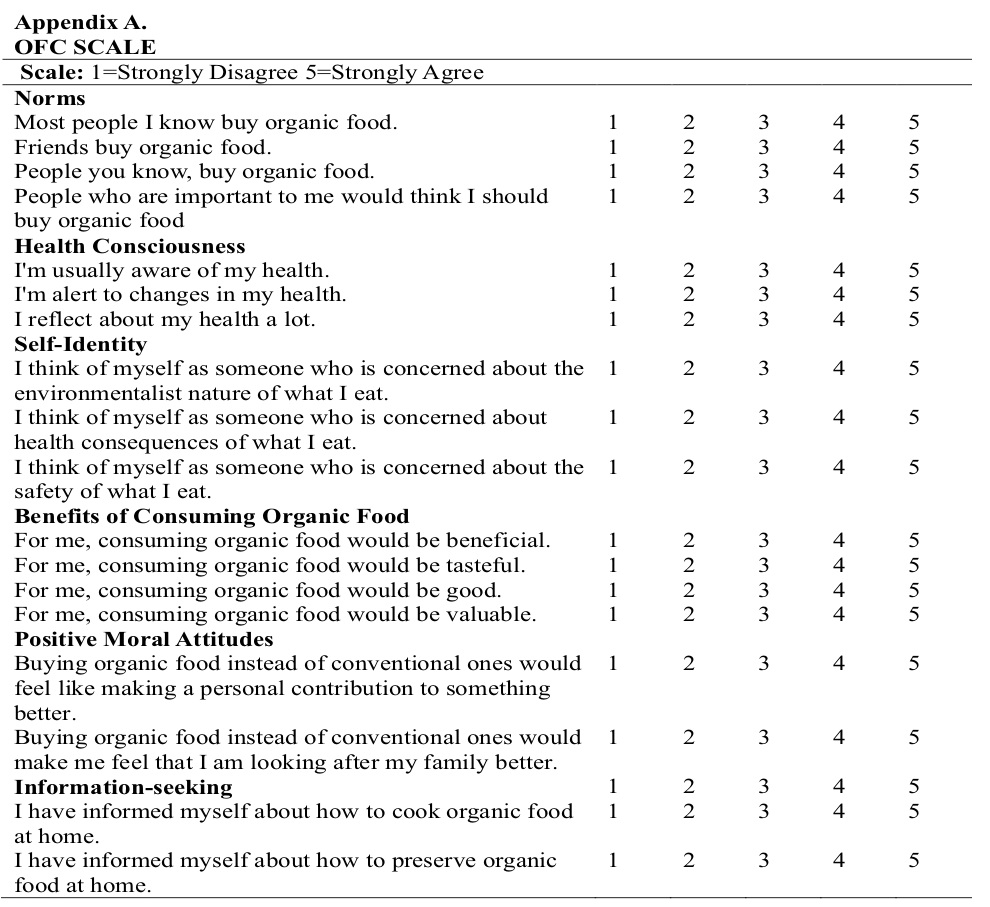|
GulnurEti Icli Department of Production Management and Marketing, Faculty of Economics and Administrative Sciences, Kirklareli University, Kirklareli, Turkey. |
Nihat Kamil Anil Department of Management and Organization, Vize Vocational Collage, kirklareli University, Kirklareli, Turkey |
Bulent Kiliç Luleburgaz Vocational College, Kirklareli University, Luleburgaz/Kirklareli, Turkey, |
The purpose of this study is to develop and validate the Organic Food Consumption Scale (“OFC”), a new measurement scale for organic food consumption. The questionnaire was administered to consumers of organic food bazaars located in Istanbul-the most populated city in Turkey where organic food bazaars were established. A total of 1000 questionnaire forms were given to consumers in these bazaars. 620 usable questionnaire forms were collected with the return rate of 62%. The OFC scale contains 18 items under 6 factor structures [Health Consciousness (HC), Benefits of Consuming Organic (BC), Information-seeking (IS), Norms (N), Positive Moral Attitude (PM), and Self-Identity (SEI)]. All the tests appeared to indicate that it is an appropriate instrument that maybe used to measure organic food consumption.
Keywords: Organic food consumption, OFC scale, Scale development, TurkeyConsumer behavior related to organic food products has become the topic of studies carried out in many countries. These studies generally lay emphasis on the way of interpretation of the consumer regarding the organic concept, consumer behavior, subjects affecting the demand, and the factors that facilitate or prevent proliferation of organic products. Many studies have focused on several aspects of organic food: perceived health and nutrition benefits (Willis & Stafford, 2016; Hsu, 2016; Yazdanpanah, 2015; Tetik, 2012; Shaharudin et al., 2010; Chen 2009; Ozcelik&Ucar,2008; Lodorfos& Dennis, 2008; Michaelidou& Hassan, 2008; Padel& Foster, 2005; Radman, 2005; Wier& Calverley 2002; Magnusson et al., 2001), people's willingness to pay a high premium for organic food (Gil et al., 2000), food safety risks (Williams and Hammitt, 2001), effect of “organic” vs. “natural” definition (Gifford&Bernard, 2011), consumers' motivation to buy organic food (Thøgersen&Zhou, 2012), effect of consumers' perceptions and attitudes toward organic food on their willingness to purchase (Suh et al., 2012). Additionally, organic food knowledge is found to be an influencer of consumer perceptions and attitudes toward organic foods (Padel&Foster, 2005; Gracia&De
Magistris, 2008). Moreover, Hsu et al. (2016) found that subjective knowledge of organic food, health consciousness and food safety concerns are important for organic food purchases. According to a survey conducted in 2013 in Turkey; those who are more sensitive to the issue of health and consider organic food more healthy focus on the following issues; organic food is more nutritious, safe, nostalgic, it tastes better and it is environmentally friendly, including animal health (Celik, 2013). Studies that areconducted in different cultures lead to different outcomes. For instance, whileenvironmental factors and organic food knowledge are found to be important elements affecting consumer attitudes towards organic food in Hong Kong, health consciousness was found to have no significant effect (Cheung et al., 2015). On the other hand, the Theory of Reasoned Action (TRA) (Ajzen and Fishbein, 1980; Fishbein and Ajzen, 1975) and the Theory of Planned Behaviour (TPB) (Ajzen, 1985, 1989, 1991) are widely used to explain consumers' organic food consumption (Chen, 2007; Dean et al., 2008; Saba and Messina, 2003; Teng and Wang, 2015). According to TRA, a person's behavioral intention depends on the person's attitude towards the behavior and subjective norm. TPB, which is the extended version of TRA, includes all the components of TRA and adds perceived behavioral control. In this study,the authors aimed to develop a scale that measures Organic food consumption of consumers which isinspired by and adapted through TPB, the Health Belief Model (HBM) and includesother variables such as self-identity and information-seeking as well. Although previous studies have examined variety of variables, this study is significant since it incorporates most of the variables that were examined in previous research to get a purified scale that maybe used for measuring organic food consumption. Health-conscious consumers feel responsible for their own and family health, get health information from a variety of sources and then apply the gained knowledge to future behaviors (Willis &Stafford, 2016). These consumers aim to motivate themselves to stay healthy and improve their quality of life, display healthy behavior and take precautions in order to decrease risks of possible diseases. According to the literature review for the reasons for preference of organic products, it maybe observed that the primary reason is health-related issues (Tetik, 2012; Shaharudin et al., 2010; Ozcelik&Ucar, 2008; Lodorfos& Dennis, 2008; Tarkiainen&Sundqvist, 2005; Padel&
Foster, 2005; Radman, 2005; Wier& Calverley 2002). Since organic food consumers are a group that is aware of health issues, they are interested in healthy and natural food and wish to buy such products (Schifferstein& Oude Ophuis, 1998).Moreover, Hsu (2016) emphasized that previous studies have shown that consumers who buy organic food actmore responsiblyregardingtheir health. Health and food safety are the two main reasons why consumers opt for organic products. The idea that organic food has higher nutritious value and is therefore healthier has an effect on the choice of organic food. Many consumers identify the most important motivation for buying organic food as the nutritious value and healthy nature of this type of food (Tetik, 2012; Chakrabarti&Baisya, 2007; Padel&Foster, 2005). It is known that organic food is preferred by consumers due to its association withhigh nutritious value and lower risk(Akgungor et al., 2010; Hsu, 2016). Additionally, the taste of organic food has been pointed out as an important elementin many studies (Lodorfos& Dennis, 2008; Magnussonet et al., 2001; Roddy et al., 1996; Mutlu, 2007). Therefore, benefits of consuming organic foodconstitutea very important factor. Consumers have begun to question food safety, especially due to several issues such as genetically modified products, additives, several artificial substances and their detrimental effects on human health. Consumers stated that their positive attitude towards organic food is stemming from artificial materials, additives, chemicals used in conventional food and the fear felt against these substances (Michaelidou& Hassan, 2008). This situation makes consumers lean more towards organic food. Moreover, in the study carried out by Pellegrini and Farinello (2009) on Italian consumers, the most important reason for preferring organic food was determined to be absence of chemicals and pesticides in organic food. Karabas and Gurler (2012) stated that 66.4% of consumers were very sensitive against materials with traces of hormones and chemicals, and that they wished to consume natural food that is free of chemicals and additives. As it was noted before, food safety is one of the two main reasons why consumers opt for organic products (Hsu, 2016). Therefore, food safety is an important indicator that is affecting the intention to buy organic food. Consumers have to be informed about organic food in order to increase the demand (De Magistris&Gracia, 2008). Moreover, information plays a vital role during decision-making regarding the purchase of organic products. Preference of products by all consumers is dependent on the increase of promotion efforts related to these products. Since the majority of consumers do not know the nature of
organic food, itsdifference from non-organic food, where to buy it orhow to keep it or cook it, they tend to display no inclination towards buying these products. The difficulties and obstacles regarding obtainment of organic food is affecting the organic food buying decisions of consumers. According to a study carried out in England, consumers stated that they didnot know where to buy organic food and that they found it cumbersome to search for it (Padel& Foster, 2005). Consumers have to be enlightened about many issues related to organic food such as whether they include additives or not, their production processes, their shapes, their nutritious value and locations to buy them. Shortly, communication efforts that explain the quality of food are required (EtiIcli, 2011).In summary, information-seeking is another crucial factor in consuming organic food. Tuu et al. (2008) determined in their study that not only the family but also the people in the social environment have an impact on the consumptionbehavior of individuals. Word-of-mouth and social influence (social activities in the society, others' thoughts about purchase behavior) are both important factors that influence intention (Cakici, 2009). For example, someone with a social environment that regularly consumes organic food will, as time passes, come to the conclusion that organic food is good for people and may begin to consume organic food. As a conclusion, in consuming organic food, normsmaybe identified as a significant factor. Perceived behavioral control is related to perception of how easy or difficult execution of a behavior is for the individual. The more sources and opportunities are available to a consumer who wishes to buy organic food, the more likely it is that this consumer will carry out the behavior. Dean et al. (2008) asserted a significant positive relationship between PBC and the intention to buy. Grønhøj et al. (2013) found in a study carried out on Danish adolescents on the subject of health nutrition that behavioral control and adolescents' own attitudes towards healthy eating had a positive impact on behavioral intention to eat healthily. In relation to perceived behavioral control and organic food consumption, several researchers pointed out higher selling prices of organic food products and lack of availability (Magnusson et al., 2001, Zanoli&Naspetti, 2002, Fotopoulos &Krystallis, 2002, and Krystallis, Fotopoulos &Zotos 2006). Even Tarkiainen and Sundqvist (2005) divided PBC into importance of price and perception of availability. Organic food that is purchased under the consideration that it is healthy consolidates the belief of an individual that they have made the right decision both for themselves and their family. Aertsens et al. (2009) included both subjective
norms and personal moral norms in their integrated framework of personal determinants of organic food consumption. Arvola et al. (2008) attested that consumers actually are awarding themselves via positive moral attitude and feeling of having made the right decision.Therefore, moral attitude is an important decisive factor for purchasing preferences. Consumers with high awareness of healthy life and those who care about what they eat and what kind of lifestyle they have prefer organic food for itshigh nutritious value and low risk. In the literature, environmental awareness is considered as an important motive supporting the purchase of organic food (Magnusson et al, 2001;Michaelidou& Hassan, 2008). Buying organic food is preferred and prioritized by people who have values such as environmental awareness and empathy for other people. Environmentally aware individuals prefer products which display the same awareness and they are also ready to pay more for such products (De Magistris&Gracia, 2008). So, self-identity is another notable factor in consumption oforganic food. Unfortunately, in order to increase production and decrease prices, various chemicals are used in an irresponsible and uncontrollable manner in agriculture. This in turn causes destruction of the natural balance in the long runand affects human health. Since organic food is chemical free, healthier, environment-friendly, more delicious, natural, and produced in a trustful manner, it is preferred more by consumers in comparison to conventional food. Many consumers have beliefs that organic food contains higher levels of nutrients (Hsu, 2016). Many studies argue that health awareness is the main factor encouraging consumers to buy organic food (Grankvist& Biel, 2001; Lockie et al., 2002). Organic products also represent environmental awareness. Thanks to their natural and environment-friendly production methods, organic products are drawing the attention of and are preferred by consumers who have developed environmental awareness (Ozcelik&Ucar, 2008; Mutlu, 2007). Lastly, there are several scales trying to measure consumers' organic food consumption in the literature, and they are using various variables. On the other hand, there are studies in the literature using the Theory of Planned Behavior and the Health Belief Model for understanding consumers' intentions of organic food consumption. Forthis study, a broad set of variables that are found important for consumers' organic food consumption in previous studies are integrated with the Theory of Planned Behavior and the Health Belief Model. This way, the authors tryto develop a broad but purified scale, which takes many aspects of consumers' organic food
consumption in consideration but at the same time, is purified offunnecessary variables that are not important for consumers' organic food consumption. Then again, understanding consumers' organic food consumption intentions and important factors that lead consumers to consume organic food from the point of a Turkish sample maybe important since organic food consumption is known to be very dependent to culture. Therefore, this study differs from previous scales and gains its importance in the literature.
Researchers may use two basic approaches to item development: the deductive approach (logical partitioning) and the inductive approach (grouping) (Hinkin, 1998). This scale development process employed the deductive approach. A44-item (Turkish) questionnaire was adapted from the relevant literature. “Health consciousness” and “ F o o d s a f e t y c o n c e r n ” i t e m s w e r e f r o m MichaelidouandHassan (2008); “Benefits of consuming organic” items were adapted from Desphande et al. (2009); items of “Information-seeking” were from Tutkun et al. (2006); items of “Norms” were from Tuu et al. (2008) and Conner et al. (2001); items of “Perceived behavioral control”, “Positive moral attitudes”, and “Beliefs” were adapted from Arvola et al. (2008); anditems of “Self-identity” were adapted from Conner et al. (2001). Authors preferred shorter scales to reduce monotony, costs, and response bias, and considered more particularly that “an increase in the number of items encourages inappropriate response behavior and gives rise to positively correlated error termsacross items among respondents” (Drolet& Morrison, 2001). Thus, it was aimed to keep the questionnaire as short as possible to save time and to get more cooperation fromthe respondents. The back to back translation method was used for the measures. All items were measured on a five-point Likert-type scale with the following values: 1 = strongly disagree, 3 = neutral, and 5 = strongly agree.
Demographic characteristics of the surveyors included their sex, age, educational background, income, job status, marital status, and number of children.
The questionnaire was administered to consumers of organic food bazaars located in Istanbul-the most populated city in Turkey and where organic food bazaars were established. All 9 organic food bazaars of Istanbul were targeted in relation to the aim of the study. Five organic food bazaars namely SisliFerikoy, Zeytinburnu,Bakirkoy, Beylikduzu, and Kucukcekmece were located in the European side of Istanbul while the remaining four bazaars namely Kartal, Maltepe, Kadikoy, Uskudar were in the Anatolian side of Istanbul. A convenience sampling method was used. A total of 1000 questionnaire forms were administered to consumers in these bazaars. In total, 620 usable questionnaire forms were collected with the return rate of 62%.
Exploratory factor analysis (EFA), Confirmatory factor analysis (CFA), and validity assessments were conducted.
The first analysis that was used was exploratory factor analysis (EFA) to assess the construct validity during the initial development of the instrument (Worthington and Whittaker, 2006).A series of principal component analyses with varimax rotation were performed. Items that had a factor loading below 0.50 were eliminated from the scale after each factor analysis, until satisfactory psychometrics properties were achieved (Negra&Mzoughi, 2012).
Many researchers suggested to perform confirmatory factor analysis (CFA) to validate new assessment instruments after exploratory factor analysis (EFA) (DeVellis, 2003; Worthington and Whittaker, 2006). Moreover, Styles (1998) indicated that while the alpha coefficient assumes different indicators have equal factor loads (k) and error variances (d), CFA takes into account the differences among the existing indicators. Likewise, Steenkamp and Van Trijp (1991) suggested that CFA proposes a better estimate of reliability than the alpha coefficient. Therefore, in this study, after the EFA, CFA was applied in order to verify the dimensionality and reliability.
Validity is the extent to which a measure or set of measures correctly represents the concept of a study. For the purpose of validating the constructs, face validity, content validity and construct validity (convergent and discriminant validity) test were conducted. Face validity is “Post hoc evidence of content validity” while content validity is “A priori evidence that the items are a good representation of the construct (from expert judges)” (Rossiter, 2002). Hinkin (1995) also asserted that content validity is the primary concern in item generation and it must be built into the measure through the development of items.
From the point of construct validity,convergent and discriminant validity were examined.Bagozzi et al. (1991) reported that “without assessing construct validity, one cannot estimate and correct for the confounding influences of random error and method variance, and the results of theory testing may be ambiguous.” Churchill (1979) recommended that convergent and discriminant validity should be assessed in investigating construct validity. According to Hair et al. (2006), “construct validity is the extent to which a set of measured items actually reflects the theoretical latent construct those items are designed to measure.” Therefore, as part of the construct validity check, analyses of convergent and discriminant validity were performed. Convergent validity refers to the extent of correlation between the intended measure and other measures used to measure the same construct (Hung &Petrick, 2010). In other words, convergent validity is used to determine whether the “indicators of a specific construct should converge or share a high proportion of variance in common” (Hair et al., 2006). To establish convergent validity, the magnitude of factor loads should be greater than .6 (Bagozzi& Yi, 1988). Discriminant validity refers to the extent of dissimilarity between the intended measure and the measures used to indicate different constructs. It can be examined by monitoring the inter-correlations among variables (Hung &Petrick, 2010). Farrell (2010) defined discriminant validity as a latent variable able to account for more variance in the observed variables associated with it than a) measurement error or similar external, unmeasured
influences; or b) other constructs within the conceptual framework. He also stressed that researchers cannot be certain whether results confirming hypothesized structural paths are real or whether they are a result of statistical discrepancies unless they assess discriminant validity. According to Diamantopoulos (2005), “establishing discriminant validity simply means that one can empirically differentiate the construct from other constructs that may be similar and that one can point out what is unrelated to the construct”. Several methods are suggested by the literature to assess discriminant validity and these include paired constructs test, average variance extracted versus squared correlation test, and Multitrait-multimethod matrix (MTMM). For paired construct test, Anderson and Gerbing (1988) recommended that the parameter estimate for two factors is constrained to 1.0 (constrained model) and compared to a model where this parameter is freely estimated (unconstrained model). For the second method, a researcher compared the AVE of each construct to the shared variance between constructs. If the AVE for each construct is greater than its squared correlation with any other construct, discriminant validity is supported (Fornell&Larcker, 1981). The last method, the MTMM method, uses more than one measure of constructs and more than one method to measure them to assess discriminant validity (Farrell, 2010).
Table 1 gives the demographic characteristics of respondents.

EFA assesses the construct validity during the initial development of an instrument (Worthington and Whittaker, 2006). A series of principal component analyses were performed with varimax rotation. Items that had a factor load below 0.50 were eliminated from the scale after each factor analysis, until satisfactory psychometrics properties were achieved (Negra&Mzoughi, 2012). Following this approach, items were retained only if
• they loaded 0.50 or more on a factor and • they did not load more than 0.50 on two factors. Analyses were progressively re-run after item deletion to ensure the integrity of the factor structure (Worthington and Whittaker, 2006). Moreover, scales with alpha values lower than .70 were excluded. Overall, 25 items were obtained and 19 items were eliminated (Table 2).


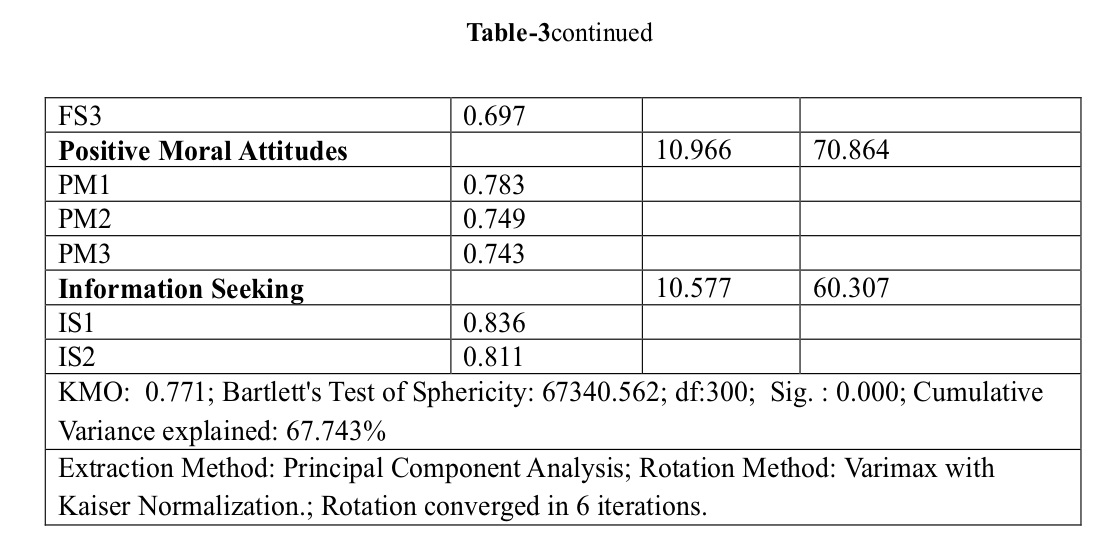
As shown in Table 3, seven underlying dimensions were derived from the factor analysis as “Norms”, “Health Consciousness”, “Self-Identity”, “Benefits of Consuming Organic Food”, “Food Safety”, “Positive Moral Attitudes” and “Information-seeking”. The Bartlett's test of sphericity result with a value of 6734.562 (p < 0.000) and the Kaiser–Meyer–Olkin statistic of 0.771 indicate that the data were suitable to identify factor dimensions. The seven factors explained 67.743% of the variance of the data of the sample
It should be noted here that in order to improve AVE the authors followed Farrell (2010)'s approach and deleted items that were listed below in Table 4.
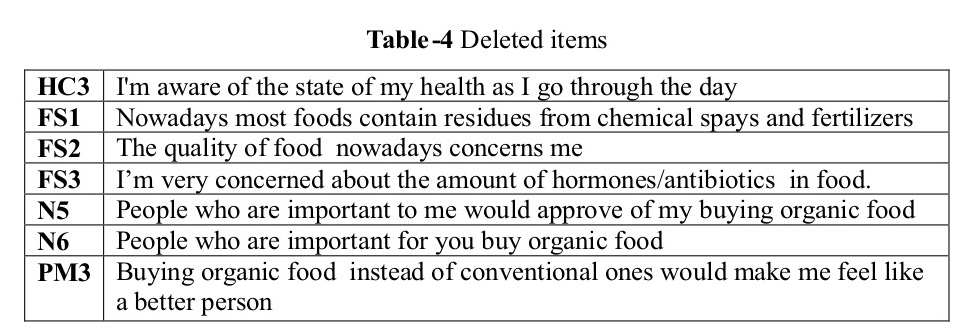
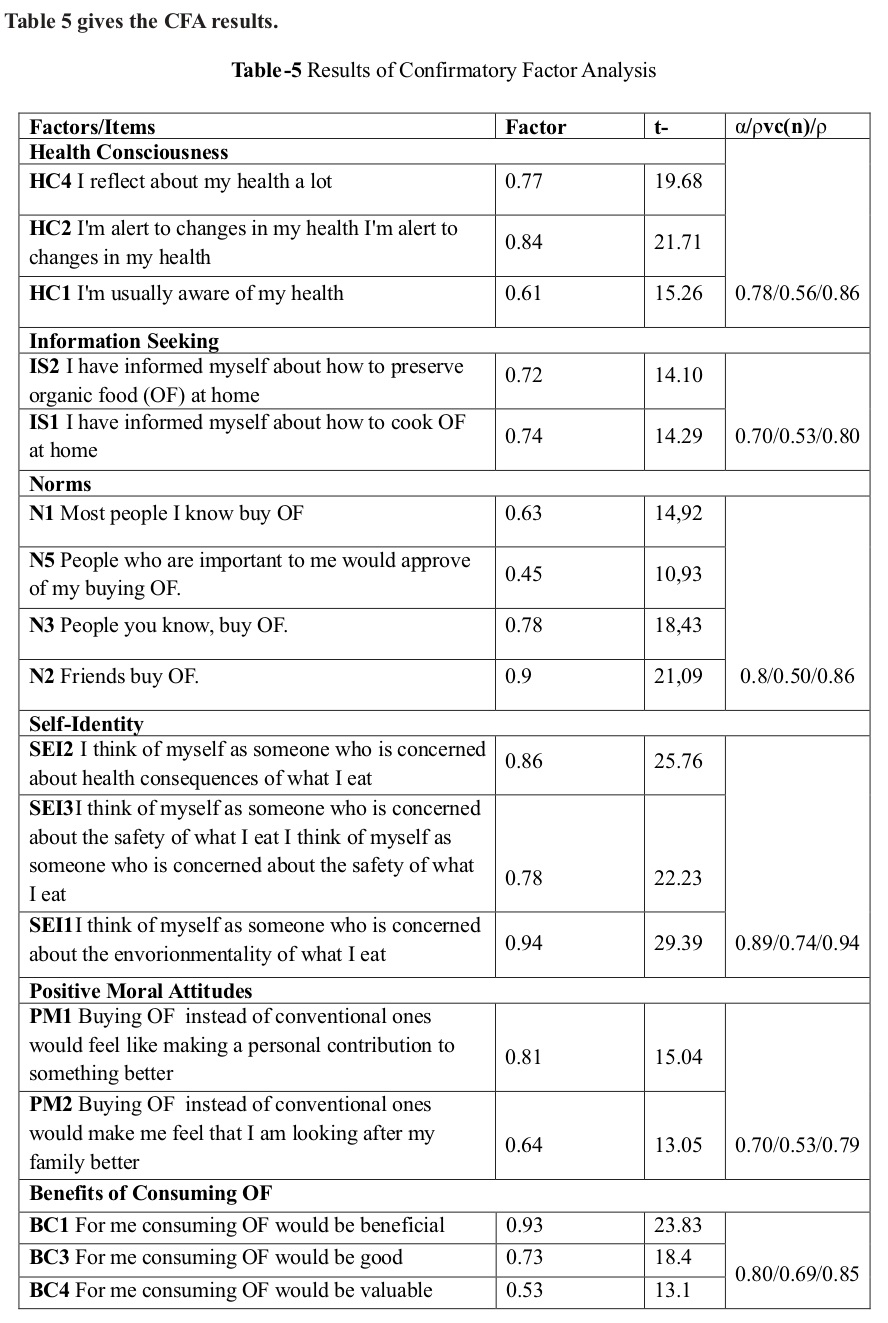

The validity of the measures was examined through a confirmatory factor analysis (CFA) with LISREL 8 (Jöreskog and Sörbom, 1996). PRELIS was used to compute the covariance matrix used by LISREL. Results (in Table 4), as interpreted by the goodness-of-fit measures, showed that the model fits the data well, confirming the convergent validity characteristic of the measures (X2/df(224.96/116) = 1.94; RMSEA = 0.039; NFI = 0.96; NNFI = 0.97; CFI = 0.98; IFI = 0.98). To verify the reliability for each dimension, Cronbach's alpha was assessed and composite reliability (ñ) was calculated. A complementary measure was the average variance extracted, which shows the amount of variance that was captured by the construct in relation to the amount of variance due to measurement error. The reliability statistics for the capability dimension are reported in Table 5. All the items were significantly related to their specified constructs, verifying the posited relationships among the indicators and constructs. The Cronbach's alphas varied from 0.70 to 0.89 and the construct reliabilities ranged from 0.79 to 0.94, both exceeding the minimum recommended level of 0.60. The average variance-extracted met the recommended 50 percent (Diamantopoulos &Siguaw, 2000 cited in Vanhala et al. 2011) in all components.
Before the data collection, the generated items weresubmitted to 8 volunteer research assistants in the Department of Business Administration who participated in the pilot survey in order to assess its content validity (Negra&Mzoughi, 2012). Following DeVellis' (2003) recommendation, the volunteer professors checked the scale items for ambiguity, clarity, triviality, sensible construction and redundancy.Given that the questionnaire was appropriately designed through a comprehensive review of the relevant literature then fined-tuned based on the recommendations from various experts, both the face validity and content validity of the instrument were ensured (Icli& Anil, 2014).
In this study, the authors used average variance extracted (ñvc(n)), composite reliability (ñ), and the item factor loads to assess convergent validity according to the following criteria: ñvc(n) >0.5, factor loads>0.6, and ñ >0.6. As shown in Table 5, the item factor loads were consistently above 0.6 (only three items had values lower than 0.6: “For me, consuming organic food would be tasteful”=.51, “For me, consuming organic food would be valuable”=.53 and “People who are important to me would approve of me buying organic food”=.45) and significant (p<0.01), therefore suggesting convergent validity. Correlations <0.90 indicate distinct constructs and low correlations indicate discriminant validity (Ruvio et al., 2008). As a test of discriminant validity, the correlations among the latent constructs were checked (in Table 6): they provided evidence of discriminant validity.
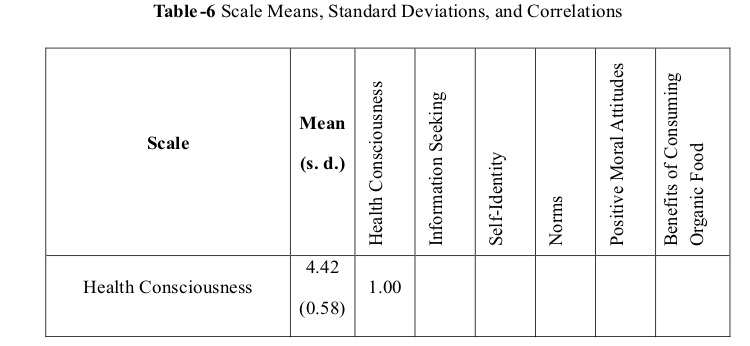
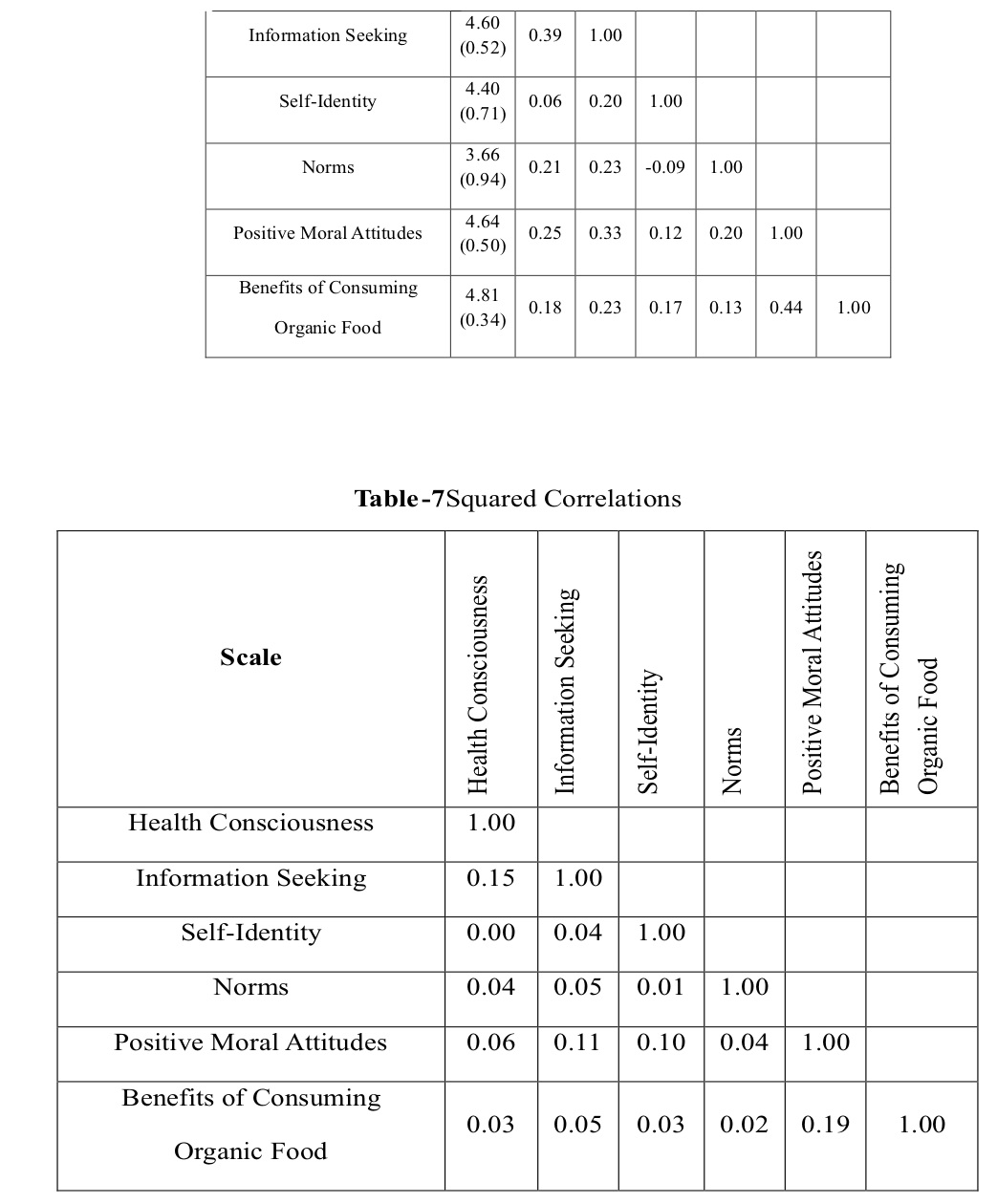
More rigorous evidence requires that the individual ñvc(n) of each construct must be higher than the squared correlation between the two constructs (Fornell&Larcker, 1981). As shown in Table 5, Table 6 and Table 7, this condition was met. Therefore, the CFA model demonstrated discriminant validity.
Although this study merges some important theories and suggests a valid instrument to measure organic food consumption, it has some limitations. First of all, it is conducted in Istanbul, Turkey with organic food consumers. The scale should be tested in other cultures and with different samples. Furthermore, the authors used convenience sampling, which limits the generalizability of the results. In future research, probability-sampling techniques may be used to increase generalizability. Mainly, future research that will try to validate this multi-dimensional scale with different samples will make great contribution to the adaptations necessary for this scale. Moreover, although the authors included many new items to the scale, there can be some other important elements for consumers in consuming organic food. For this reason, future research could begin by exploratory research such as focus groups or in-depth interviews by organic food consumers to reveal other possible important reasons for organic food consumption. Besides, this study concentrated on the organic food consumers but the underlying reasons of non-consumers for not consuming organic food can be another important research area. OFC scale is a multidimensional scale, which is added many more dimensions by this research. The question is whether consumers scoring higher in different dimensions could behave differently. Thus, future research could focus on consumers' different behavioral tendencies based on the various dimensions of this scale
The aim of this study was to develop an organic food consumption scale. By this aim based on the literature and inspired by TPB and HBM, the authors included the dimensions Health Consciousness (HC), Benefits of Consuming Organic (BC), Food Safety (FS), Information-seeking (IS), Norms (N), Perceived Behavioral Control (PBC), Positive Moral Attitude (PM), Self-Identity (SEI), and Beliefs (B). After exploratory and confirmatory factor analyses, the purified scale consisted of Health Consciousness (HC), Benefits of Consuming Organic (BC), Information-seeking (IS), Norms (N), Positive Moral Attitude (PM) and Self-Identity (SEI). Food safety (FS), Perceived Behavioral Control (PBC), and Beliefs (B) components were deleted based on the analyses' results.
This study shows the important elements that lead consumers to consume organic food. This is important both for academics, practitioners and public policy. From the point of practitioners, organic food marketers can target health conscious consumers or try to improve the health consciousness of consumers and can give them information to attract information-seeking consumers. On the other hand, organic food marketers can emphasize benefits of consuming organic, norms, positive moral attitude and self-identity. On the other hand, academics who want to measure organic food consumption can use this scale since it is specifically designed for this purpose. From the point of public policy, since the issue of organic food is an important concern from the point of sustainability, this scale can be used to spot organic food consumers and increase the consumption by non-consumers. From a managerial point of view, this scale could be used as a segmentation tool that consumers scoring higher in different dimensions could have different expectations from organic food companies or brands. Thus companies can target some of the consumer groups that they choose and create different marketing strategies such as communicating differently with different consumer groups. Also, from a brand management perspective, different brand names could be needed to target different consumer groups whose expectation from organic food is different.
Aertsens, J., Verbeke, W., Mondelaers, K., & Van Huylenbroeck, G. (2009). Personal determinants of organic food consumption: a review. British Food Journal, 111(10), 1140-1167. Anderson, J.C., &Gerbing, D.W. (1988).An updated paradigm for scale development incorporating unidimensionality and its assessment.Journal of Marketing Research, 25/2, 186-193. Arvola, A., Vassallo, M., Dean, M., Lampila, P., Saba, A., Lahteenmaki, L., & Shepherd, R. (2008).Predicting intentions to purchase organic food: The role of affective and moral attitudes in the Theory of Planned Behaviour, Appetite, 50, 443-454. Bagozzi, R. P. (1980).Causal models in marketing.New York: John Wiley and Sons. Bagozzi, R. P. & Yi, Y. (1988).On the evaluation of structural equation models.Journal of the Academy of Marketing Science, 16/1, 74–94. Bagozzi, R. P., Yi, Y., Phillips, L.W. (1991). Assessing c o n s t r u c t v a l i d i t y i n o r g a n i z a t i o n a l research.Administrative Science Quarterly, 36/3,
421-458. Cakici, N.M. (2009). Attitudes and Purchase Intentions Of Consumers For Organic Products In The Turkish Market.Yeditepe University Graduate Institute of Social Sciences, Unpublished PhD Thesis, Istanbul. Celik, S. (2013).Kimler, NedenOrganikGýda Satýn Alýyor? Bir Alan Araþtýrmasý.Selcuk University Journal of Institute of Social Sciences, 30, 93-108. Chen, M. F. (2009). Attitude toward organic foods among Taiwanese as related to health consciousness, environmental attitudes, and the mediating effects of a healthy life style.British Food Journal, 111/2, 165-178. Cheung, R., Lau, M.M. and Lam, A.Y.C. (2015), “Factors affecting consumer attitude towards organic food: an empirical study in Hong Kong”, Journal of Global Scholars of Marketing Science, Vol. 25 No. 3, pp. 216-231. Churchill, G.A. Jr. (1979). A paradigm for developing better measures of marketing constructs.Journal of Marketing Research, 16, 64–73. Conner, M., Kirk, S. F., Cade, J. E., & Barrett, J. H. (2001).Why do women use dietary supplements? The use of the theory of planned behaviour to explore beliefs about their use.Social Science and Medicine, 52, 621-633. Cronbach, L. J. (1951).Coefficient alpha and the internal structure of tests.Psychometrika, 22/3, 297-334. Dean, M., Raats, M.M. and Shepherd, R. (2008).Moral concerns and consumer choice of fresh and processed organic foods.Journal of Applied Social Psychology, Vol. 38 No. 8, 2088-107. De Magistris, T. &Gracia, A. (2008).The decision to buy organic food products in Southern Italy. British Food Journal,110 8-9, 929-947. DeVellis, R. F. (2003). Scale development: Theory and applications. (2nd ed.).Thousand Oaks, CA: Sage. Diamantopoulos, A. &Siguaw, J.A. (2000).Formative Versus Reflective Indicators in Organizational Measure Development: A Comparison and Empirical Illustration.British Journal of Management, 17, 263–282. Diamantopoulos, A. (2005). The C-OAR-SE procedure for s c a l e d e v e l o p m e n t i n m a r k e t i n g : A comment.International Journal of Research in Marketing, 22, 1-9. Drolet, A.L., & Morrison, D.G. (2001).Do we really need multiple-item measures in service research?Journal
of Service Research, 3/3, 196-205. EtiÝcli, G. (2011).OrganikGýdaveTüketiciDavranýþlarý.In Taskin, C. (Ed.), GüncelPazarlamaYaklaþýmlarý. Ýstanbul:AlfaAktuelYayinlari. Farrell, A.M. (2010). Insufficient discriminant validity: A comment on Bove, Pervan, Beatty, and Shiu (2009).Journal of Business Research, 63, 324–327. Fornell, C. &Larcker, D. (1981).Evaluating structural equation models with unobservable variables and measurement error.Journal of Marketing Research, 28, 39–50. Fotopoulos, C. and Krystallis, A. (2002), “Organic product avoidance: reasons for rejection and potential buyers' identification in a countrywide survey”, British Food Journal, Vol. 104Nos 3/5, pp. 233-60. Gifford, K. and Bernard, J.C. (2011), “The effect of information on consumers' willingness to pay for natural and organic chicken”, International Journal of Consumer Studies, Vol. 35 No. 3, pp. 282-289. Gil, J.M., Gracia, A. and Sanchez, M. (2000), “Market segmentation and willingness to pay for organic products in Spain”, International Food and Agribusiness Management Review, Vol. 3 No. 2, pp. 207-226. Gracia, A. and Magistris, T.D. (2008), “The demand for organic foods in the south of Italy: a discrete choice model”, Food Policy, Vol. 33 No. 5, pp. 386-396. Grankvist, G.,& Biel, A. (2001).The importance of beliefs and purchase criteria in the choice of eco-labeled food products.Journal Of Environmental Psychology,21/4, 405-410. Grønhøj, A., Bech-Larsen, T., Chan, K., &Tsang, L. (2013).Using theory of planned behavior to predict healthy eating among Danish adolescents.Health Education, 113/1, 4-17. Hair, J. F., Black, W. C., Babin, B. J., Anderson, R. E., &Tatham, R. L. (2006).Multivariate data analysis. (6th ed.).New Jersey: Prentice Hall International. Hinkin, T. R. (1995).A review of scale development practices in the study of organizations.Journal of Management, 21,967–988. Hinkin, T.R. (1998). A brief tutorial on the development of measures for use in survey questionnaires. Organizational research methods, 1, 104-121. Hung, K., &Petrick, J. F. (2010).Developing a m e a s u r e m e n t s c a l e f o r c o n s t r a i n t s t o cruising.Annals of Tourism Research, 37/1, 206–228.
Hsu S. Y., Chang, C.C., &Lin, T.T. (2016).An analysis of purchase intentions toward organic food on health consciousness and food safety with/under structural equation modeling.British Food Journal, 118/1, 200-216. Icli, G. E. & Anil, N. K. (2014).The HEDQUAL scale: A new measurement scale of service quality for MBA programs in higher education.South African Journal of Business Management,45/3, 31-43. Jöreskog , K.G. &Sörbom, D. (1996).LISREL 8 User's reference guide.Chicago, USA: Scientific Software International. Karabas, S. &Gurler, A. Z. (2012).OrganikÜrün TercihindeTüketiciDavranýþlarýÜzerineEtkiliFaktö rlerinLogitRegresyonAnalizi Ýle Tahminlenmesi. AdýyamanÜniversitesiSosyalBilimlerEnstitüsüDer gisi, 10/5 (Aralik), 129-156. Krystallis, A., Fotopoulos, C., &Zotos, Y. (2006).Organic consumers' profile and their willingness to pay (WTP) for selected organic food products in Greece. Journal of International Consumer Marketing, 19(1), 81-106. Lockie, S., Lyons, K.,Lawrence, G., &Mummery, K. (2002).Eating 'green': Motivations behind organic food consumption in Australia.SociologiaRuralis, 42/1,23-40. Magnusson, M.K., Arvola, A., KoivistoHursti, U.K., Aberg, L., &Sjoden, P. (2001).Attitudes towards organic foods among Swedish consumers.British Food Journal, 103/3, 209-227. Matsuno, K., Mentzer, J.T., &Rentz, J.O. (2000).A refinement and validation of the MARKOR scale. Journal of the Academy of Marketing Science, 28/4, 527-539. Michaelidou, N. & Hassan, L. M. (2008).The Role of Health Consciousness, Food Safety Concern and Ethical Identity on Attitudes and Intentions towards Organic Food.International Journal of Consumer Studies, 32/2, 163-170. Negra, A. &Mzoughi, N. (2012).How Wise are Online Procrastinators? A Scale Development.Internet Research, 22/4, 426–442. Noar, S. M. (2003). The role of structural equation modeling in scale development, structural equation modeling. A Multidisciplinary Journal, 10/4, 622-647. Padel, S. and Foster, C. (2005), “Exploring the gap between attitudes and behavior understanding why
consumers buy or do not buy organic food”, British Food Journal, Vol. 107 No. 8, pp. 606-625. Rossiter, J.R. (2002). The C-OAR-SE procedure for scale development in marketing.International Journal of Research in Marketing,19/4, 305–335. R u v i o , A . , S h o h a m , A . , & B r e n c i c , M . M . (2008).Consumers' need for uniqueness: short-form s c a l e d e v e l o p m e n t a n d c r o s s - c u l t u r a l validation.International Marketing Review, 25, 33–53. Schifferstein, H.N.J., & Oude Ophuis, P.A.M. (1998).Health-related determinants of organic food consumption in the Netherlands.Food Quality and Preference,9/3, 119-133. SteenkampJ.E.,& Van Trijp H.C. (1991). The use of LISREL in validating marketing constructs. International Journal of Research Marketing, 8/4, 283–299. Styles C. (1998). Export performance measures in Australia and the United Kingdom. Journal of International Marketing, 6/3, 12–36. Suh, B.O., Eves, A. and Lumbers,M. (2012), “Consumers' attitude and understanding of organic food: the case of South Korea”, Journal of Food Service Business Research, Vol. 15 No. 1, pp. 49-63. Tarkiainen, A., Sundqvist, S. (2005). Subjective norms, attitudes and intentions of Finnish consumers in buying organic food. British Food Journal, Vol. 107(11), 808 – 822 Teng, C-C., Wang, Y-M. (2015), Decisional factors driving organic food consumption: Generation of consumer purchase intentions, British Food Journal, Vol. 117 No. 3, pp. 1066-1081. Tetik,S.(2012).TürkTüketicisininOrganikÜrünTercihEtm e s i n e N e d e n O l a n FaktörlerinUygulamaliOlarakÝncelenmesi.Uluslar arasýHakemliBeþeriveAkademikBilimlerDergisi, 1/1, 1-29. Thøgersen, J. and Zhou, Y. (2012), “Chinese consumers' adoption of a 'green' innovation – the case of organic food”, Journal of Marketing Management, Vol. 28 No. 3-4, pp. 313-333. Tutkun, A., Lehmann, B., & Schmidt, P. (2006).Explaining the conversion to organic farming of farmers of the Obwalden Canton, Switzerland – Extension of the Theory of Planned Behavior within a Structural Equation Modeling Approach.In80th Annual Conference of the Agricultural, Paris-Grignon. Tuu, H. H., Olsen, S. O., Thao, D. T., &Anh, N. T. K.
International Journal of Pharmaceutical and Healthcare Marketing,10/2, 130-147. Worthington, R.L., &Whittaker,T.A. (2006). Scale development research. Acontent analysis and r e c o m m e n d a t i o n s f o r b e s t p r a c t i c e s . CounselingPsychology, 34, 806–838. Yazdanpanah, M., Forouzani, M.,&Hojjati, M. (2015). Willingness of Iranian young adults to eat organic foods: Application of the Health Belief Model. Food Quality and Preference, 41, 75–83. Zanoli, R. and Naspetti, S. (2002), “Consumer motivations in the purchase of organic food”, British Food Journal, Vol. 104 No. 8, pp. 643-53
